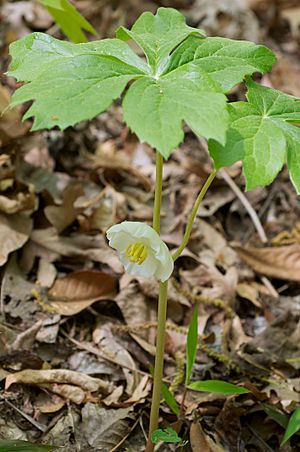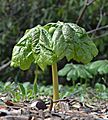Podophyllum facts for kids
Quick facts for kids Mayapple |
|
|---|---|
 |
|
 |
|
| Podophyllum peltatum | |
| Conservation status | |
| Scientific classification | |
| Genus: |
Podophyllum
|
| Species: |
peltatum
|
| Synonyms | |
|
|
The Mayapple (scientific name: Podophyllum peltatum) is a cool plant found in woodlands. It's a type of herbaceous perennial plant, which means it has soft stems (not woody like a tree) and lives for many years. It belongs to the Berberidaceae family.
This plant was first described by a famous scientist named Carl Linnaeus in 1753. While there used to be many plants called Podophyllum, now only the Mayapple remains in this group. You might also hear it called American mandrake, wild mandrake, or ground lemon. It grows widely across the eastern United States and southeastern Canada.
Mayapples often grow in large groups, like a big family, all connected by one underground root system. Their stems can grow to be about 30–40 cm (12–16 inches) tall. The leaves are very distinctive, looking like little umbrellas! They can be 20–40 cm (8–16 inches) wide and have 3 to 9 deep or shallow cuts.
The plants grow several stems from a creeping underground stem called a rhizome. Some stems only have one leaf and don't produce flowers or fruit. But the stems that do flower usually have two or more leaves with 1 to 8 flowers growing where the top leaves meet the stem. These flowers can be white, yellow, or red, and are about 2–6 cm (1–2.5 inches) wide with 6 to 9 petals. After the flowers, a fleshy fruit grows, which can be green, yellow, or red and is about 2–5 cm (1–2 inches) long.
It's important to know that most parts of the Mayapple plant are poisonous, especially the green fruit. However, once the fruit turns fully yellow, it can be safely eaten in small amounts. The ripe yellow fruit is not toxic.
People also grow Mayapples as ornamental plants because their leaves and flowers are very pretty. They are also a food source for the caterpillars of certain moths, like the golden borer moth and the may apple borer.
Even though it's called "mayapple," the flower often appears in early May, not the "apple" (fruit). The fruit usually grows in early summer and ripens later in the summer.
Many plants have special helpers called mycorrhizae, which are fungi that live on their roots. These fungi help the plants get nutrients from the soil, especially in places where the soil isn't very rich. Mayapple plants really need these mycorrhizae to grow well. Mayapple plants can also get a common plant disease called rust, which looks like orange spots under the leaves and yellowish spots on top.
Mayapple: Safe or Not?
It's very important to remember that the unripe green fruit of the Mayapple is toxic. The leaves, stems, and roots are also poisonous. However, the ripened yellow fruit can be eaten in small amounts. Some people even make it into jelly! But eating too much, even of the ripe fruit, can still be harmful.
The Mayapple plant contains a substance called podophyllotoxin. This substance is very toxic if you eat it. However, it can be used as a medicine applied to the skin.
Mayapple's Medicinal Uses
For a long time, American Indians used the Mayapple for various medicinal purposes. They used it as an emetic (to make you throw up), a cathartic (to help with digestion), and an antihelmintic (to get rid of worms). Later, other settlers also learned to use the plant's underground stem (rhizome) for medicine.
Today, Mayapple can be used on the skin to remove warts. Also, two medicines derived from Mayapple, called etoposide and teniposide, have shown promise in treating some cancers. Etoposide is so important that it's on the World Health Organization's list of essential medicines.
Gallery
See also
 In Spanish: Podophyllum para niños
In Spanish: Podophyllum para niños







